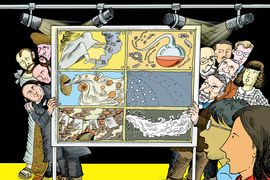The Covid-19 pandemic taught us how complex the science and management of infectious disease can be, as the public grappled with rapidly evolving science, shifting and contentious policies, and mixed public health messages.
The purpose of scientific communication is to make the complexity of such topics engaging and accessible while also making sure the information conveyed is scientifically accurate. With that goal in mind, one MIT team recently transformed themselves into time-traveling comic book characters, in an effort to convey the fascinating history of infectious disease science.
The multimedia project, “A Paradigm Shift in Infectious Diseases,” follows its creators — and the story’s protagonists — on a journey through scientific history. MIT Associate Professor Lydia Bourouiba and cancer-researcher-turned-graphic-artist Argha Manna travel across the world, leaping from one century to the next to learn about paradigm shifts in science from philosophers of science and to meet scientific luminaries and other scholars as they changed the understanding of infectious diseases and their transmission.
“Our goal with this project was to communicate effectively about the scientific method,” says Bourouiba, director of MIT’s Fluid Dynamics of Disease Transmission Laboratory, part of the Fluids and Health Network; a core faculty member of the Institute for Medical Engineering and Science (IMES); and an associate professor in the departments of Civil and Environmental Engineering and of Mechanical Engineering. “During crises like the Covid-19 pandemic, we saw a lot of confusion and misunderstanding from the public that stemmed, in part, from a lack of knowledge about how science actually evolves.”
The project was exhibited in MIT’s Rotch Library Gallery last month and was the subject of an event at the Hayden Library that explored broader questions about the scientific method and scientific literacy. The authors are currently in talks with publishers to create a comic book from the story, and Bourouiba is teaching a related class, HST.537/1.063/2.25 (Fluids and Diseases), this spring.
The exciting history of infectious disease research
Bourouiba pitched the idea for the exhibit to the MIT Center for Art, Science and Technology (CAST) in 2021 during the Covid-19 pandemic. CAST agreed to fund the project, which also received support from the Department of Civil and Environmental Engineering, IMES, and the MIT Libraries.
“We wanted to use visual art in the form of comics, which allows us to convey multilayered messages, with the two protagonists traveling through time and locations to try to understand the processes that led to the different understandings of infectious diseases and how they are transmitted,” Bourouiba explains.
Like all good science communication, the project tells a story. The comic starts with Bourouiba and Manna discussing how infectious diseases spread. They read about experiments by William F. Wells in the 1930s, focusing on the size of exhaled droplets and how it determines how fast they evaporate. And they learn about the origins of germ theory, which after much pushback and debate, was eventually established by Louis Pasteur and Robert Koch toward the end of the 19th century. Soon, Bourouiba and Manna are transported back in time to come face to face with the subjects of their study. The adventure brings them to ancient Greece, Egypt, Italy, and eventually back to MIT — but in the 1940s — where Harold “Doc” Edgerton conducted pioneering work on stroboscopic photography, which could capture images of moving droplets in previously unprecedented detail.
“Through the adventure of the protagonists in this comics, one learns that the evolution of ideas on infectious diseases is far from solely a school of medicine effort,” Bourouiba says. “Instead, it involved, from its start, physicists, ecologists, engineers, and modelers, in addition to those managing public good, eventually establishing public health structures.”
Through it all, the audience learns about various “paradigm shifts” in science that mark progress and put in perspective contemporary shifts in our understanding of infectious disease.
The power of science communication
A panel at the Hayden Library served to launch the exhibit and included Professor Joel Gill, associate professor of art and chair of the Department of Visual Narrative at Boston University; Edward Nardell, professor of global health and social medicine at Harvard Medical School; Carl Zimmer, New York Times journalist and author; John Durant, then-director of the MIT Museum and adjunct professor in the MIT Program in Science, Technology, and Society (STS); and Robin Scheffler, associate professor in MIT STS.
The panel discussed shifts in ideas about science and how we communicate them using media like videos, books, and comics.
“We need to think about our audience, we need to know the audience we’re talking to, and we need to be prepared to listen as well as to speak to the audience,” Durant said. “We also need to find ways of moving outside of the circle of people who think the way we do.”
In Scheffler’s talk, he showed examples throughout history of scientists using art and artists using science.
“By thinking about the slippery-ness between [art and science] and having a greater sense that there isn’t a hard and fast line to draw in terms of paradigm shifts in science, I think we can all have a more empathetic and practical approach in how we communicate and talk about the nature of changing science and changing understandings of disease,” Scheffler said.
Ultimately, the comic exemplifies an idea by one of its central characters, Doc Edgerton. The famed educator once said, “The trick to education is to teach people in such a way that they don’t realize they’re learning until it’s too late.”












